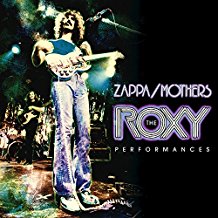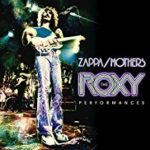
If compared to a crop, the tapes of the December 1973 concerts by Frank Zappa and the Mothers recorded at the Roxy experienced drought, some genetic engineering, some root cellar storage, and ultimately, a bountiful harvest. Technical problems initially plagued Zappa’s attempt to turn the recording and filming of four shows over two days into a movie and a soundtrack. Instead, a few tracks surfaced on Roxy and Elsewhere and again on a remixed Roxy by Proxy, and the movie finally saw the screen in 2015, two decades after his death. So, here it is, finally, 45 years later, released as the highly anticipated, complete, intact, end-to-end set of not only those four performances but also a soundcheck, a rehearsal, and recording session. Everything from those December days during and surrounding those legendary appearances is here.
As a document of Zappa history, it is essential. Mixed by Craig Parker Adams, the seven discs sound sonically wonderful, putting the listener right in the middle of the intimate West Hollywood venue. Zappa held a reputation for bands of exceptional skill, and certainly each ensemble had its own personality. This one- a septet featuring George Duke, Tom Fowler, Bruce Fowler, Napoleon Murphy Brock, Ruth Underwood, Ralph Humphrey and Chester Thompson- could be argued was his best. At the very least, it’s his most soulful and funky. Duke’s keyboard work is virtuosic and show-stealing, leaving Zappa to play less lead guitar, and supported by the poly-rhythmic force of Humphrey and Thompson on drums and Underwood’s note-perfect percussion and vibes. Brock’s horn playing and vocal delivery are stellar, matched by Bruce Fowler’s symbiotic trombone and brother Tom’s brilliant bass. It is a joy to sit back and listen to these commanders of their craft at the peak of their Zappa tenure.
The repertoire allows for plenty of muscle-flexing, but it’s always as a collective. Pockets of groove emerge out of Zappa’s tightly-written arrangements, like the best jazz combo on the planet stretching out beyond the terrestrial borders. The second show of the first night- December 9, 1973- contains the most extended jamming of the run and is endlessly entertaining and awe-inspiring. Renditions of classics such as “Penguin in Bondage,” “Pygmy Twylyte,” and “Cosmik Debris,” populate several shows and are executed as efficiently as ever, but it’s the more obscure “Big Swifty” and “Dupree’s Paradise” that serve as vehicles for transcendent musicianship and incomparable group dynamic. Zappa may have been a taskmaster, but he also knew how to turn a band loose. And this band takes full advantage of their freedom.
Of the seven, the soundcheck/film shoot disc feels slightly excessive, meant for the completist rather than the casual. It’s a lot more informal than the other performances, with Zappa shouting direction to cameramen and stagehands while the band works through the material. Otherwise, every piece has something very special to offer. Every note is more than worthy of being heard. Every Zappa fan can finally rejoice.



No Comments comments associated with this post